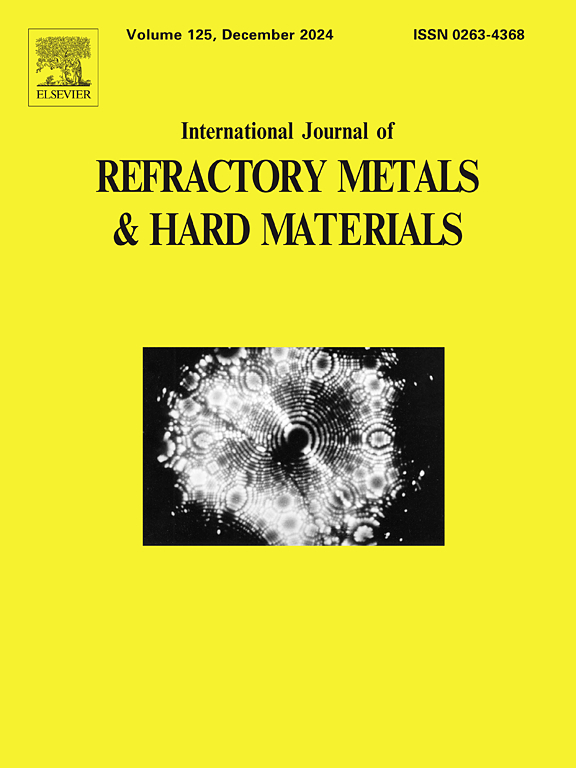无粘结剂碳氮化钛基纳米陶瓷复合材料的增强性能:微观结构、性能和机理的综合研究
IF 4.2
2区 材料科学
Q2 MATERIALS SCIENCE, MULTIDISCIPLINARY
International Journal of Refractory Metals & Hard Materials
Pub Date : 2025-05-18
DOI:10.1016/j.ijrmhm.2025.107232
引用次数: 0
摘要
传统陶瓷因其脆性和温度敏感性而面临挑战。本研究介绍了一种新的固溶体强化策略,通过纳米粒子杂交和烧结参数优化来制备具有增强摩擦学和热力学性能的无粘结碳氮化钛纳米复合材料(BTC)。通过混合纳米颗粒和优化的烧结条件,BTC获得了优异的力学性能,其抗弯强度为948±167 MPa,维氏硬度为20.17±0.95 GPa,断裂韧性为6.66±1.03 MPa·m2 /2,分别比单一纳米颗粒复合材料提高了106.9%,17.7%和105.4%。值得注意的是,在干滑动情况下,与商用WC-6Co相比,它的摩擦系数降低了11.01%,磨损率降低了26.84%。即使在1000°C时,仍保持9.32±0.20 GPa的高硬度。此外,通过详细的微观表征摩擦和磨损,这些性能增强背后的具体机制被清楚地阐明。此外,通过实验分析和理论建模,定量揭示了BTC的微观组织演变和增韧强化机理。因此,本研究为开发先进的碳氮化钛基复合材料提供了坚实的基础。本文章由计算机程序翻译,如有差异,请以英文原文为准。
Enhanced properties of binderless titanium carbonitride based ceramic nanocomposites: An integrated study of microstructure, performance, and mechanisms
Traditional cermets face challenges due to brittleness and temperature sensitivity. This study introduces a novel solid solution strengthening strategy, achieved through nanoparticle hybridization and optimization of sintering parameters, to develop binderless titanium carbonitride nanocomposites (BTC) with enhanced tribological and thermomechanical properties. By tailoring the dense microstructure through hybrid nanoparticles and optimized sintering conditions, BTC achieves exceptional mechanical properties, a flexural strength of 948 ± 167 MPa, Vickers hardness of 20.17 ± 0.95 GPa, and fracture toughness of 6.66 ± 1.03 MPa·m1/2, exceeding the composites containing only single nanoparticle by 106.9 %, 17.7 %, and 105.4 %, respectively. Notably, it achieves 11.01 % lower friction coefficient and 26.84 % reduced wear rate compared to commercial WC-6Co under dry sliding. Even at 1000 °C, a high hardness of 9.32 ± 0.20 GPa is retained. Moreover, through detailed microscopic characterization of friction and wear, the specific mechanisms behind these performance enhancements are clearly elucidated. Additionally, the experimental analysis and theoretical modeling quantitatively unveil the microstructure evolution, toughening and strengthening mechanisms in BTC. Consequently, the present study provides robust foundation for the development of advanced titanium carbonitride based composites.
求助全文
通过发布文献求助,成功后即可免费获取论文全文。
去求助
来源期刊
CiteScore
7.00
自引率
13.90%
发文量
236
审稿时长
35 days
期刊介绍:
The International Journal of Refractory Metals and Hard Materials (IJRMHM) publishes original research articles concerned with all aspects of refractory metals and hard materials. Refractory metals are defined as metals with melting points higher than 1800 °C. These are tungsten, molybdenum, chromium, tantalum, niobium, hafnium, and rhenium, as well as many compounds and alloys based thereupon. Hard materials that are included in the scope of this journal are defined as materials with hardness values higher than 1000 kg/mm2, primarily intended for applications as manufacturing tools or wear resistant components in mechanical systems. Thus they encompass carbides, nitrides and borides of metals, and related compounds. A special focus of this journal is put on the family of hardmetals, which is also known as cemented tungsten carbide, and cermets which are based on titanium carbide and carbonitrides with or without a metal binder. Ceramics and superhard materials including diamond and cubic boron nitride may also be accepted provided the subject material is presented as hard materials as defined above.

 求助内容:
求助内容: 应助结果提醒方式:
应助结果提醒方式:


